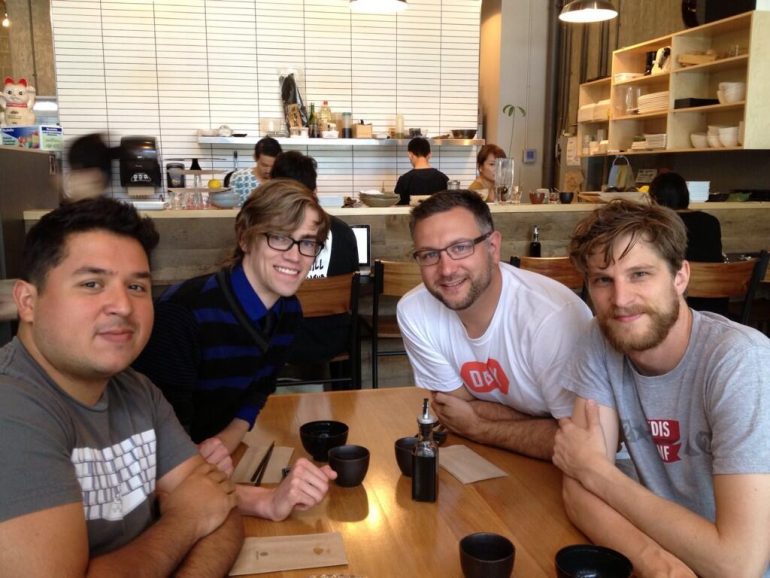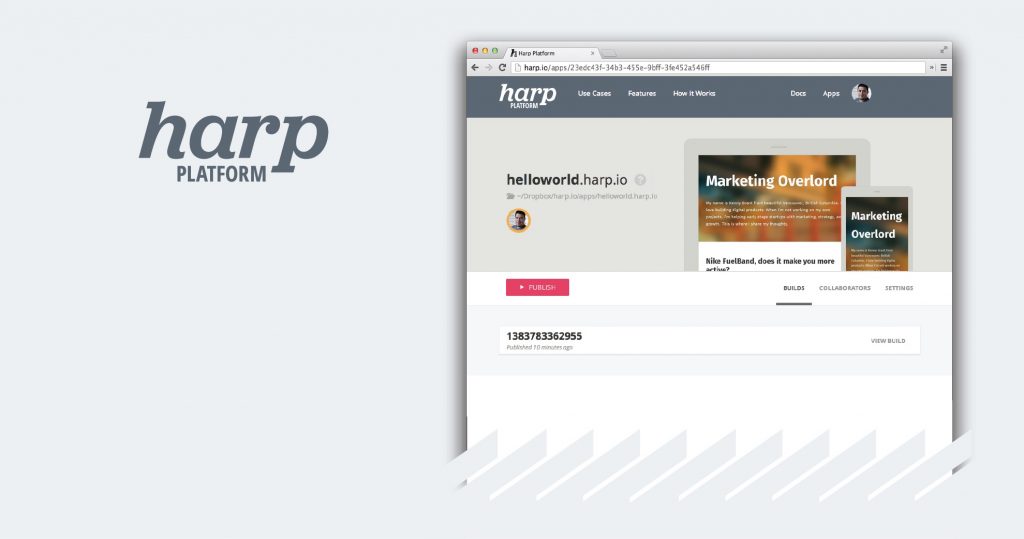From cave paintings and papyrus, Gutenberg to Edison, and from smoke signals to the Motorola DynaTAC 8000X, communicating is in our DNA.Yet the history of communications is about barriers. From ownership of infrastructure to the cost of the tools themselves, the price of being heard or the cost of spreading the word has often been limited to the few.
The invention of the printing press, the radio, the telephone, and the television has changed the things we think about, the symbols we think with, and the space in which our thoughts develop. These are the legacy tools for communicating. But communicating with each other is the promise of the Web. Tim Berners Lee said “the world-wide web is conceived as a seamless world in which all information, from any source, can be accessed in a consistent and simple way.”
In many ways this promise is still unfulfilled. Publishing on the web can be complex, and it’s easy to understand why developers are in such demand.
Harp.io cofounders Rob Ellis and Brock Whitten have spent the past two years with the goal of reinventing web publishing. The Harp Platform is a low risk, easy to start and rapid iteration publishing tool for the web, exposing the power of the web while getting out of your way. They’re making it open, easy and simple for developers, designers, creators, and writers.
The Harp team are strongly committed to the open source community. The platform doesn’t lock-in users, who are free to take their apps, websites, or blogs and host them anywhere by exporting them as static assets or by running the Harp web server.
Going back to their days of working together on PhoneGap, solving big development challenges isn’t new to Ellis and Whitten. According to Whitten, the genesis for the Harp platform stems from “frustrations even going back to PhoneGap. Even though dev at that point was focused on web technology, it didn’t have a focus on the web. The environment and the ecosystem was really messy and full of friction. You still needed a lot of domain knowledge about different SDK’s and devices while the web still wasn’t addressed in terms of getting things online.”
The pair spent considerable time brainstorming about what was the easiest possible way to develop a mobile application. Whitten says “we both came to the conclusion that there would be nothing easier than a folder on your machine, and what’s in there is in production.”
For these two it’s ultimately about the promise of the web. “The point isn’t that we’re building this product, the point is that the web is the product,” said Whitten. “Someone has to remove all of the paper-cuts, so that it is truly simple, easy and delivers on the promise that the web gave us over a decade ago.”
A key part of the platform is the Harp web server which does all the implicit pre-processing for you. You don’t have to write HTML, CSS, & JavaScript directly, you can use a variety of CSS pre-processors and eliminate compile steps. This allows for the sharing of layouts, reusing templates, writing in Markdown and not having to concern yourself with the environment at all.
Ellis said “we’ve essentially built two things, the platform and the web-server. The web-server appeals to a different audience particularly the designer, developer, hacker, and tinkerer. This has been by design, much like how we approached PhoneGap. First thing was to build something open-source, add a tremendous amount of value to that, build an ecosystem around that and see where it goes. The Harp web-server is that free, open source piece.”
These two cofounders have considered trends and are transcending their vision of what web publishing could be, into reality. “The native development on mobile was kind of a wake-up call for the web, because it delivered on the promise of usability and end-user experience,” said Whitten. “We can’t take months or years to get to market anymore. The web’s biggest advantage is that it’s easy and low friction, and that means some of the groundwork needs to be taken care of.”
Ellis added that the trends played a big part in Harp.io, like the clear distinction that arose between frontend and backend developers with the advent of the API. “We’re making a platform primarily for the frontend, so publishing assets and deploying your site whether it’s a blog or the next Facebook it can all be built on the frontend with the tools we’ve put together,” he said.
Publishing with the Harp Platform is about owning, managing and controlling a repository of digital assets. Via DropBox or Git, this is now your database, your filesystem and the source control. It’s about publishing being a richer, simpler, easier experience.
A blog post is just a document, and it doesn’t need to be more.



